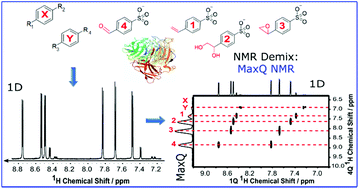2D and 3D maximum-quantum NMR and diffusion spectroscopy for the characterization of enzymatic reaction mixtures
Abstract
1D 1H NMR spectroscopy has been widely used to monitor enzymatic activity by recording the evolution of the spectra of substrates and/or products, thanks to the linear response of NMR. For complex systems involving the coexistence of multiple compounds (substrate, final product and various intermediates), the identification and quantification can be a more arduous task. Here, we present a simple analytical method for the rapid characterization of reaction mixtures involving enzymatic complexes using Maximum Quantum (MaxQ) NMR, accelerated with the Non-Uniform Sampling (NUS) acquisition procedure. Specifically, this approach enables, in the first analytical step, the counting of the molecules present in the samples. We also show, using two different enzymatic systems, that the implementation of these pulse sequences implies precautions related to the short relaxation times due to the presence of metallo-enzymes or paramagnetic catalysts. Finally, the combination of MaxQ and diffusion experiments, which leads to a 3D chart, greatly improves the resolution and offers an extreme simplification of the spectra while giving valuable indications on the affinity of the enzymes to the different compounds present in the reaction mixture.



 Please wait while we load your content...
Please wait while we load your content...